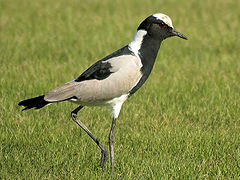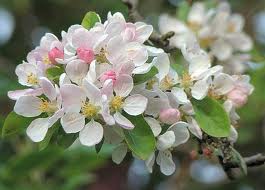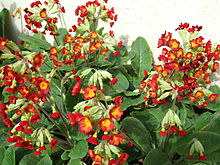From the The Naturalist’s Diary of April 1826
The breath of Spring is on thee, Aspley Wood (near Woburn in Bedfordshire).
Each shoot of thine is vigorous, from the green,
Low-drooping larch, and full unfolded bud
Of sycamore, and beech, majestic queen!
With her tiara on, which crowns the scene
With beauty,–to the stern oak, on whose rind
The warmest suns and sweetest showers have been,
And soft voice of the fond Favonian wind:–
His thousand lingering leaves reluctantly unbind
But of all other trees, a clustering crowd
Bow their young tops rejoicingly to meet
The breeze, which yet not murmurs over-loud,
But wastes on Nature’s cheek its kisses sweet,
To woo her from dark winter;–the wild bleat
Of innocent lambs is on the passing gale,
Blending with pastoral bells; and at my feet,
From yon warm wood the stockdove’s plaintive wail
Wins to the curious ear o’er the subjected vale.
Wiffen’s Aonian Hours.
In this picturesque and beautiful description of the poet, the effects of Spring on forest scenery are faithfully delineated, and convey to the mind a vivid representation of the beauties to be observed by those who mark the gradual progress of vegetation. But in Nature, beauty is almost always combined with utility; and while the senses are feasted with the great variety of colours and odours abounding among flowers and plants, the contemplative mind naturally considers the beneficial effects that result from this beautiful combination of vegetable wonders. All is connected (observes M. Mirbel) in the vast system of the globe, and order emanates from the equipoise of conflicting phenomena. Animals carry off the oxygen of the atmosphere, replacing it by carbonic acid gas; and are thus at work to adulterate the air, and render it unfit for respiration. Vegetables take up acid gas, retain the carbon, and give out oxygen; and are thus purifying the air tainted by animals, and re-establishing the necessary proportions between its elements. In Europe, while our vegetables, stripped by the severity of the season of their foliage, no longer yield the air contributing to life, the salutary gas is borne to us by trade winds from the southernmost regions of America. Winds from all quarters of the world intermingle thus the various strata of the atmosphere, and keep its constitution uniform in all seasons, and at all elevations. The substances which are produced by the dissolution of animal and vegetable matter, diluted with water, are absorbed by plants, and constitute a portion of the nourishment by which they are maintained; plants in turn become the food of animals, and these again the prey of others which subsist on flesh. In spite of this perpetual state of war and destruction, nothing perishes, for all is regenerated. Nature has ordained that the two great divisions of organized beings should depend the one upon the other for support, and that both the life and death of individuals should be equally serviceable in keeping up the races of them.
The arrival of the swallow, about the middle of this month, foretells the approach of summer, whose coming, however is too often retarded by the return of Winter in an angry mood, hurling his last hail-storms at the ‘proud-pied’ and flower-wreathed head of April.
After the swallow, the next bird that appears is the nightingale (Motacilla luscinia) whose praises have been chimed by poets of every clime, and have occupied many a page in this month’s Diary of our previous volumes. In our climate, the nightingale seldom sings above six weeks, generally commencing the last week in April.
Nightingale
That beautiful bird the wryneck next makes its appearance, preceding the cuckoo by a few days,–whose note that tells of the advancing Spring, and its floral pleasures, is hailed with delight by every lover of Nature.
The other summer birds of passage which arrive this month, make their appearance in the following order: the ring-ousel; the redstart, frequenting old walls and ruinous edifices; the yellow wren, the swift, the white throat, the grasshopper lark, the smallest of the lark kind; and the willow wren, which, as well as house-wren, destroys many pernicious insects. The kite now approaches farmhouses, and villages in search of food and materials for constructing his nest; at other times, unless pinched by hunger, he cautiously avoids man, and all his haunts.
Blacksmith Lapwing
In April, or early in the next month, the lapwing, or pee-wit (Tringa vanellus), lays her eggs, and sits, for she makes no nest. A few pairs will retire to heaths, downs, or ploughed fields during the season of incubation, but the greater portion of them fix their stations upon the banks of the dikes of marshes, or the great drains in our fenny districts. The feathered tribe are now busily engaged in forming their temporary habitations, and in rearing and maintaining their offspring.
The vine expands its empurpled leaves. Honesty, or moonwort, is in flower; and the new sprung leaves of the sweet chestnut, in their turn, are playing in the breeze.
Various kinds of insects are observed in this month; as the jumping spider, seen on garden walls; and the webs of other species of spiders are found on the bushes, palings, outsides of houses. The Iulus terrestris appear, and the death-watch beats early in the month. The wood-ant begins to construct its large conical nest. Little maggots, the first state of young ants, are now to be found in their nests. The shell-snail comes out in troops; and the stinging-fly and the red-ant appear.
The mole-cricket is the most remarkable of the insect tribe seen about this time. The blue-flesh-fly, and the dragon-fly, are frequently observed towards the end of the month. The great variegated Libellula, which appears, principally, towards the decline of summer, is an animal of singular beauty. The cabbage butterfly, also, now appears. The black slug abounds at this season.
Of the beetle tribe now on the wing, the Scolytus destructor may be noticed for its extraordinary powers of injuring trees. It is described, in Kirby and Spence’s Introduction to Entomology, as feeding on the soft inner bark only, and as making its attacks in such vast numbers, that 80,000 have been found on a single tree. The leaves of the trees infested become yellow; the trees themselves die at the top, and soon entirely perish. Their ravages have been long known in Germany, and the insect is formally mentioned in the old liturgies of that country.
The dung of animals swarms at this season with minute Coleoptera; several species of the Lepidoptera will also be found by carefully inspecting garden pales, gates in lanes &c. Many species of bees may be seen sucking the pollen from the sallow which blossoms at this season. Sand and gravel pits should be carefully examined, and under the stones and clods of earth many insects will be discovered.”—Samouelle’s Introduction to British Entomology, p. 315.
The progress of vegetation is general and rapid in this month. The sloe puts forth its elegant flowers; a host of others follow, among which may be named the ash, ground-ivy, and the box tree. The wild and garden-cherry, the plum, gooseberry and currant trees, the sycamore, the apricot and the nectarine, are in flower:–the garden now is full of
Crimson hues
Of the first tint, by April brought
To the sweet peach-bud.
Apple Blossoms
The blossoms of the apple and pear present to the eye a most agreeable spectacle, particularly in those counties which abound with orchards. The almond-tree, whose blush colour blossoms make their appearance before any leaves are seen, is among the earliest of the flowering fruit-trees, and forms a splendid ornament to the shrubbery in the months of March or April.
The beech, the larch, and the elm, are now in full leaf. The larch also exhibits its red tufts or flowers, which soon expand into cones, and the fir tribe show their cones also. Many lovely flowers are showered from the lap of April; among them may be named jonquil, anemone, ranunculus, polyanthus, and the crown-imperial. The double-white, the yellow, and some others of the earlier tulips, are fully opened in this month; but the more illustrious varieties will not blow for some weeks.
The yellow star of Bethlehem in woods; the vernal squill among maritime rocks; and the wood-sorrel, are now in flower. This and the wood anemone have both white blossoms, and inhabit shady woods.
The way-side violet is still seen and loved for its own and for remembrance sake; and the hedge-banks are now studded with primroses the bright yellow of those flowers, beautifully contrasted with the surrounding green of the budding trees, offers a most agreeable spectacle to the lover of Spring scenery. Other flowers which adorn our fields at this time are the checquered daffodil, the lady-smock, the hare-bell, and the cowslip.
Red-Flowered Cowslip



